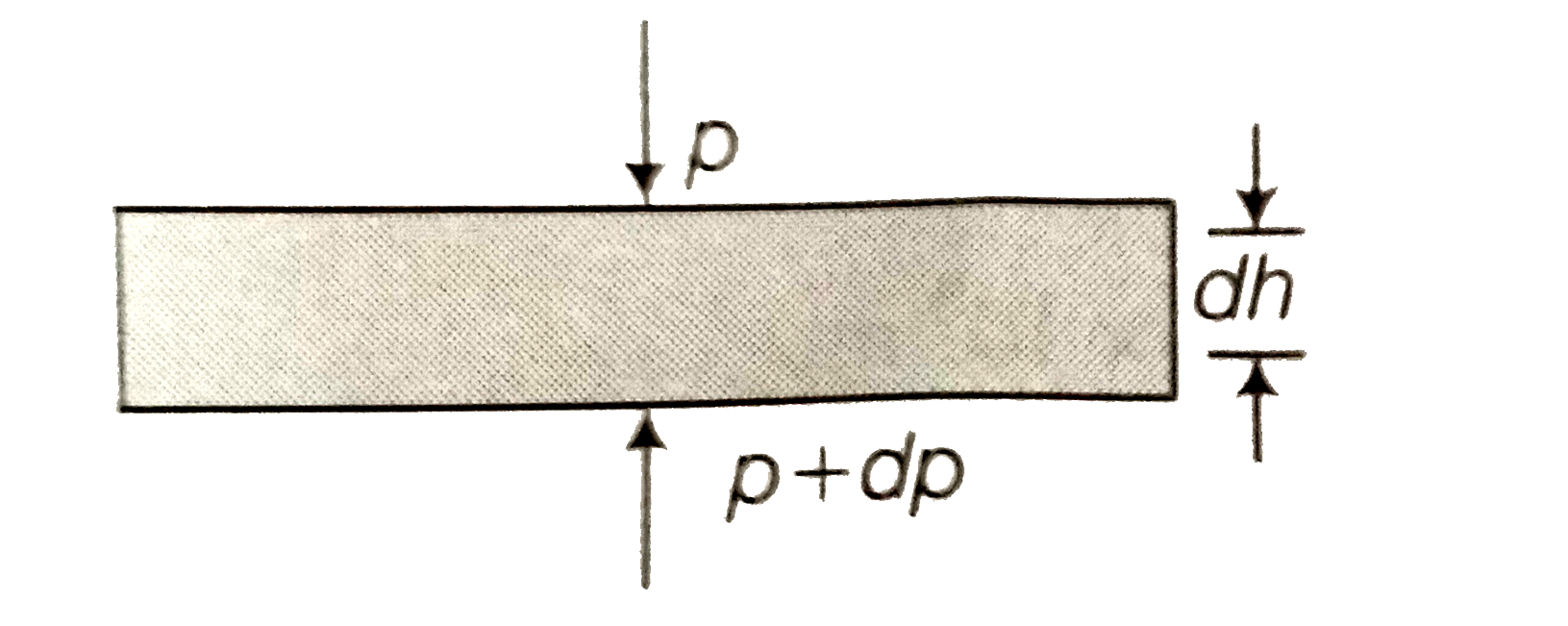(a) Pressure decreases as one ascends the atmosphere. If the density of air is ρ, What is the change in pressure dp over a differential height dh ? (b) Considering the pressure p to be proportional to the density, find the pressure p at a height h if the pressure on the sureface of the earth is p0. (c ) If p0=1.03×105Nm−2,ρ0=1.29kgm−3andg=9.8ms−2, at what height will the pressure drop to (1/10) the value at the surface of the earth ? (d) This model of the atmosphere works for relatively small distance. Identify the underlying assumption that limits the model.
Consider a horizontal parcel of air with cross-section A and height dh.

Let the pressure on the top surface and bottom surface be p and p+ dp. If the parcel is in equilibrium , then the net upward force must be balanced by the weight.
i.e., (p+dp)A−pA=−ρgAdh (∵ weight =Density × Volume ×g)
=−ρ×Adh×g
⇒dp=−ρgdh. (ρ= density of air )
Negative sign shows that pressure decreases with height .
(b) Let p∘ be the density of air on the surface of the earth.
As per question, pressure ∝ density
⇒pp∘=ρρ∘
⇒ρ=ρ∘p∘pdh [∵dp=−ρgdh]
⇒dpp=−ρ∘gp∘dh
⇒p∫p∘dpp=−ρ∘gp∘h∫0dh [∵at h=0r=p∘and at h=hp=p]
⇒Inpp∘=−ρ∘gp∘h
By removing log, p=p∘e(−ρ∘ghp∘)
(c) As p=p∘e−ρ∘ghp∘,
⇒Inpp∘=−ρ∘ghP∘
By question,
p=110p∘
⇒In⎛⎝110p∘p∘⎞⎠=−ρ∘gp∘h
⇒In110=−ρ∘gp∘hρ∘
h=−p∘ρ∘gIn110=−p∘p∘gIn(10)−1=p∘p∘gIn10
=p∘ρ∘g×2.303 [∵ In (x)=2.303log10(x)]
=1.013×1051.22×9.8×2.303=0.16×105m
=16×103m
(d) We know that p∝ρ (when T=constant i.e., isothermal pressure)
Temperature (T) remains constant only near the surface of the earth , not at greater heights.
Related Playlists
- BOOK - NCERT EXEMPLAR ENGLISHCHAPTER - MECHANICAL PROPERTIES OF FLUIDSEXERCISE - Short Answer Type Questions5videos
MECHANICAL PROPERTIES OF FLUIDS
- BOOK - NCERT EXEMPLAR ENGLISHCHAPTER - LAWS OF MOTIONEXERCISE - Long answer Type Questions9videos
LAWS OF MOTION
- BOOK - NCERT EXEMPLAR ENGLISHCHAPTER - MECHANICAL PROPERTIES OF SOLIDSEXERCISE - LONG SHORT ANSWER TYPE QUESTION16videos
MECHANICAL PROPERTIES OF SOLIDS
Similar Questions
If P is the pressure and ρ is the density of a gas, then P and ρ are related as :
View SolutionIt P is the pressure and ρ is the density of a gas, then P and ρ are realted as :
View SolutionIf P is the pressure of a gas and ρ is its density , then find the dimension of velocity in terms of P and ρ .
View SolutionThe pressure of confined air is p. If the atmospheric pressure is P, then :-
 View Solution
View SolutionThe pressure of confined air is p. If the atmospheric pressure is P, then :-
 View Solution
View SolutionIf the atompspheric pressure is Pa then the jpressure P at depth a below the surface of a liquid of density ρ open to the atmosphere is
View SolutionA small air bubble of radius r in water is at depth h below the water surface. If P0 is the atmospheric pressure, ρ is the density of water and T is the surface tension of water, what is the pressure inside the bubble?
View Solutionfind the density of air at any height and hence the height at which it is halved. Assume that the temperature reamins fixed throughout the atmosphere. The pressure at the earth's surface is P0=1.012×105Nm−2 and density po=1.293kgm−3
View SolutionLiquid of density ρ in a container exerts pressure P given by (height of liquid h and area A)
View SolutionThe density of water at the surface of ocean is ρ . If the bulk modulus of water is B, then the density of ocean water at depth, when the pressure at a depth is αp0 and p0 is the atmospheric pressure is
View Solution

